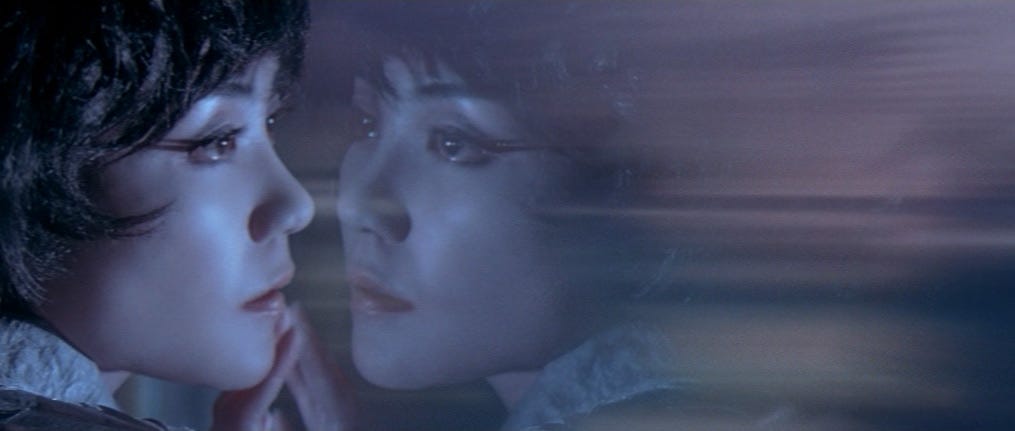◡◶▿ TIME02 | Movies for airports
🛫 Re-editing Christian Marclay's The Clock to improve the narrative pacing. Slip-Slop hits app store. The secret tunnel linking One Battle with Sweet East. New Systems of Time Week 2
📹 Unfound Peoples Videotechnic | Cloud-based filmmaking thought. ☁️
Dear perpetual film students,
I remember when my dad brought home our second-ever VHS recorder in the late 1980s. Among other startling features, when you powered it up, the display said “HELLO” - and when you turned it off, it told you “GOODBYE.” It was my first experience of expanded home cinema and my first experience with an AI therapist.
It is curious what we desire, what we need, and what pleases us in our developing technologies. Both as consumers and creators. The ever-informed and insightful Mike Gioia wrote about the new Sora generative AI video app this week. He believes its makers have hit a sweet spot between AI video’s promise, its reality, and our wallets. Uh-oh!
We’ll talk more about that after today’s micro-essay. Interesting! And relevant. It is relevant because today we are thinking about movies as an ambient presence in your life and in your living room. Specifically, about the movie-as-clock.
Missed a week? Joined late? Don’t worry about reading these lessons out of order. Each functions independently. They are sent in a sensible sequence but hardly reliant on it.
Yes, last week’s lesson was about making time weird/weird time in your movie, but this week’s is about creating a supernormal relationship between your movie and the time that passes outside of it.
Last week, we learned how:
A film is a self-contained universe - and the filmmaker sets the weather, the gravity, and the time system.
Filmmakers tend to use their many tools to arrange normal time weirdly for their audience - but rarely make weird time normal for their characters.
A smattering of alternative time behaviours might be used as a leaping point for imagining original narratives for diegetic physics.
Such innovations needn’t be considered “science fiction” so much as “utilising the full potential of cinema’s unique storytelling palette.”
But this week, we’ll consider:
☯️ The practical potential of your character’s pulses and the beating world around them.
🔥 The cinematic promise of early timepieces.
🔫 The genre rules of the ‘clock movie.’
🚉 Ambient cinema in everyday spaces.
You don’t have to use these instructions to build a clock movie. Maybe you’ll find a way to make your movie function as a SAD lamp, a star chart, or a lawnmower! I haven’t checked if that’s possible yet.
Movies for airports
You can hear me deliver this lesson by scrolling up to the header and clicking Listen and/or the play ▸ button.
In the very olden days, those who needed to follow “the time” observed the drip of a water clock or a trail of burning incense to trace the creep of the hours.
The dwindling water or incense might be integrated with sound-making mechanisms to draw attention to intervals of note. Golden balls landing in brass cups. A little pizzazz on the hour.
With all this light, sound, movement, and pizzazz, it’s little wonder they didn’t invent movies sooner!
But looked at the other way around, it seems a shame that the apparatus of moviemaking is not put towards developing new timepieces.1
It is not impossible to imagine a narrative movie whereby:
the pulse of the characters’ habits, feelings, tribulations, moments, waitings, and battles mark out the time in a manner that is easy to read or at least recognise.2
the rhythms of light and sound serve not only the movie’s narrative and theme but the ‘real world’ schoolboy chasing his bus, the executive timing her TED talk.
We know from the design world that things that are useful are often beautiful. Useful things become beautiful by dint of the human assumptions and perversions of nature by which blank matter is made into or part of a mechanism.
We also know that there is no design without narrative and that true beauty is narrative’s residue.
But that any movie in which the underlying narrative is the filmmaker’s own quest to “create beauty” can never be truly beautiful.
Movies are not usually supposed to be useful or decorative. Even if some are vainly imagined to be activist or beautiful. But might the filmmaker set out to create their movie as a useful thing? And hope that the choices and mistakes she makes along the way imbue it with that residue, that aura?
To be truly useful, this clock film had better not be distracting. Instead, such a film might exist ambiently. Ambiently, because the action decorates the flow of time. Rather than defining a fixed wedge of time.
Time itself becomes not “almost a character” but “totally a setting.” This setting exceeds the interest value of the characters. Time does not exist to let stuff happen. Instead, the hero, the plot, and the action serve the purpose of marking or colouring time. Kiefer Sutherland’s 24 on a quiet day.
No single moment - no tick or plot twist - should be essential to appreciate the movie in full. The clock should be useful, not demanding. That a clock ticks on to itself when ignored is part of its harsh beauty. A symptom of its mechanisms and of human silliness.
It is a thrill to catch a glimpse of your watch carrying on regardless when you wake in the night. Or to watch a film at a time of day that society or your controlling sense of decency proscribes. And there is some sense of love or fellowship in “checking in with the hero” each time you check the time. Every time you want to see how long your dog has been in with the vet, or when your supervisor is back from lunch.
Music has its “night bus” genre, its “hangover at the airport, noise cancelling on, hoodie up safe space” albums. Why doesn’t narrative cinema?
True, ‘Slow’ movies drop us into an atmosphere for 80 minutes or seven hours. But a true clock movie like this should not be labelled slow (nor fast) unless faulty (note: those ancient water clocks ran slow as the water pressure diminished). It should not be labelled slow or fast, since it is harnessed to time itself. (To which time should it be harnessed?)
Despite its artistic and narrative value, this movie for airports should be useful without the need to follow an arc, no matter how slight.
However, it may slot in with the ‘transcendental style.’ The clock movie transcends plot or catharsis and settles on a different plane of being. It engages directly with the mechanisms of the universe. As Brian Eno put it about ambient music, you “get the impression that you’ve caught part of an endless process,” that the movie is “something that is going on anyway.”
Such a movie cares no more about its individual audience members than the wind, the wallpaper, the clock think about the humans in their embrace.
Please share your thoughts, queries, and exercises from this week’s lesson in the comments.
TikTok for slip-slop
So. Sora 2 is here. It’s OpenAI’s latest video generator. They also describe it as a “useful world simulator.” (Unfortunately, given the rate at which we’re burning through this world, the company’s concept of “world” is two-dimensional.)
Mike Gioia “worked in TV writers rooms, independent film, and technology” and now “sorta work[s] in all three of those designing AI systems.” In his new thinkpiece, Gioia suggests the Sora app exists on the time-attention-narrative matrix not as a direct competitor to handmade modes of narrative cinema-making but as an (un)natural successor to TikTok (let’s call it SlipSlop).
Why?
Sora’s strength (reports Gioia) is in producing standalone sketches rather than longer-form plots (for which AI remains a “clumsy tool”). But this (says Gioia) is not a limitation so much as good timing.
It’s good timing because Generation Alpha - smartphone natives born after 2010 - have grown snooty towards “plot-based media.” They respect the sequential3 micro-narrative (non-)structure4 of the feed. For emerging media consumers, the latter is natural and correct.
Further, Sora’s strength (reports Gioia) is in producing. “Media creation is fully recreational here.”
The user enters a simple prompt into the app.
Potentially including their face (or a friend, fancy, or celebrity).
The simpler the better - Sora has no time for ‘prompt engineers.’
“There’s significant meta-prompting happening so that any user input is expanded into a high quality Sora prompt that will produce a good output.” (Gioia)
Sora cooks up a video;
the user re-prompts to extend or fine-tune their video and
eventually shares it directly to the feed, which is also in the app.
The point is the doing. The quest for the ultimate Sora 2 video exists somewhere between the quest for the ultimate wave and the quest for the ultimate last tweet, Instagram image, or doomy news story before switching off your phone at bedtime.
“You can be sub-literate and still create fun videos,” reports Gioia (and from this point in his article, I read the rest in the voice of Werner Herzog). It is easy to sneer, and perhaps we should. Let’s sneer! But OpenAI has tapped into the science of scrolling by hooking the user up to the mode of production; it’s as easy to make an attention-grabbing video as it is to hit that Like button.
So the Sora app is a toy. Nothing wrong with that. And it is not the first toy to have a terrible impact on the natural world nor to be vulnerable to - and maybe intended for - misuse5.
It’s a toy, not a hobby or an art. But a toy can become a hobby. A hobby can become an art. In the case of Sora 2, with its easy sense of power and its ultra-real moving images, plenty of users will wrongly imagine they’ve become hobbyists or artists.
But for those of us concerned with handmade modes of narrative cinema-making in the more-or-less physical universe, this toy is not a threat. It is a slight new mediaphysical vector to take into account when drawing up your cinematic universe.
The mediaphysical universe has shifted slightly with Sora 2’s manifestation/exploitation of new modes of attention: the atomisation of the grand narrative, the smartwatch feed as nickelodeon. I, for one, will continue to set my watch by the moon.
On that note, there are morning pastries to eat.
Next week, we’ll talk about cake time. And I promise the emails will get shorter.
Class dismissed,
~Graeme Cole.
(Principal)
P.S. This week’s not entirely non-pertinent song recc comes courtesy of discovering that the writer of the theme to The Sweet East (the people’s One Battle After Another) played Billy Goat in OBAA. Knew there had to be a connection!
🦋 Bluesky | ⏰ TikTok | 📸 Instagram | 😐 Facebook | 🎞️ Letterboxd | 🌐 unfound.video
We know that Christian Marclay made a movie that resembles a clock. He edited a 24-hour sequence of clock footage and timey dialogue from cinema history. He called it The Clock (2010). But it does not fit the description of the clock we are trying to imagine here, because:
The Clock’s surface narrative is time itself.
It flattens the sculptural effect that time assumes in the movies. (Even in the most conventionally delivered narratives set in the most normal time systems.)
Its underlying narrative is the monumentality of Marclay’s endeavour.
Look at that title: The Clock. The Clock of all clocks. It is a monumental piece, a centre (of attention) piece and not an ambience (an aroundness).
Writes Andrew Norman Wilson: “Marclay merely presents fragments in which measured time is explicitly marked. Stripped of their narrative contexts, the clips figure more as cultural objects than habitable fictional worlds.”
Other, dispersed narratives may be identified only by direct concentration and the borrowed imaginative energy of the viewer.
Five of the six editions of the video are owned by galleries that limit admissions during busy periods.
(Imagine being told to wait outside, but you don’t have a watch and have no idea how long you’re waiting.
How much keener your desperation to get inside and use the damn clock would become!)
The audience is expected to pay close attention.
(An exception is the sixth edition, which is kept as a timepiece in the owner’s office.)
Much the way that the time told by a water clock dilates as the pressure falls, the time that Marclay’s clock delivers is faulty through a mismatch of mediaphysical realms.
In this case, the variable pressure is applied to the viewer as they attempt to maintain an even flow of attention.
As such, the clock is neither a “narrative movie,” nor beautiful, nor useful. Clearly, it would be more useful at an airport or on a smart watch. And become more beautiful the longer it sat there, yellowing, gormlessly useful and losing its glamour through over-familiarity.
In Marclay’s defence, smart watches didn’t exist when he made the thing. But Marclay does admit he chose not to install The Clock in railway stations because it would be unseen during closed hours. This is a matter of vanity. And it discounts Marclay’s clock from our present quest for a cinematic machine that is either useful or ambient or both.
And apparently, it’s low-resolution, too!
One character tells the minutes. Another reacts on the hours.
And meta-accumulative, in that they mostly tell different standalone stories but contribute to or report on the culture’s broader narratives. Cf. the Spectacle.





